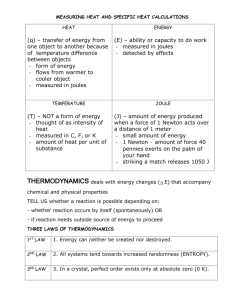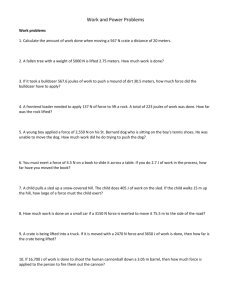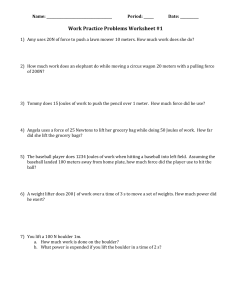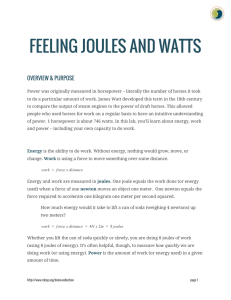Document 10638538
advertisement
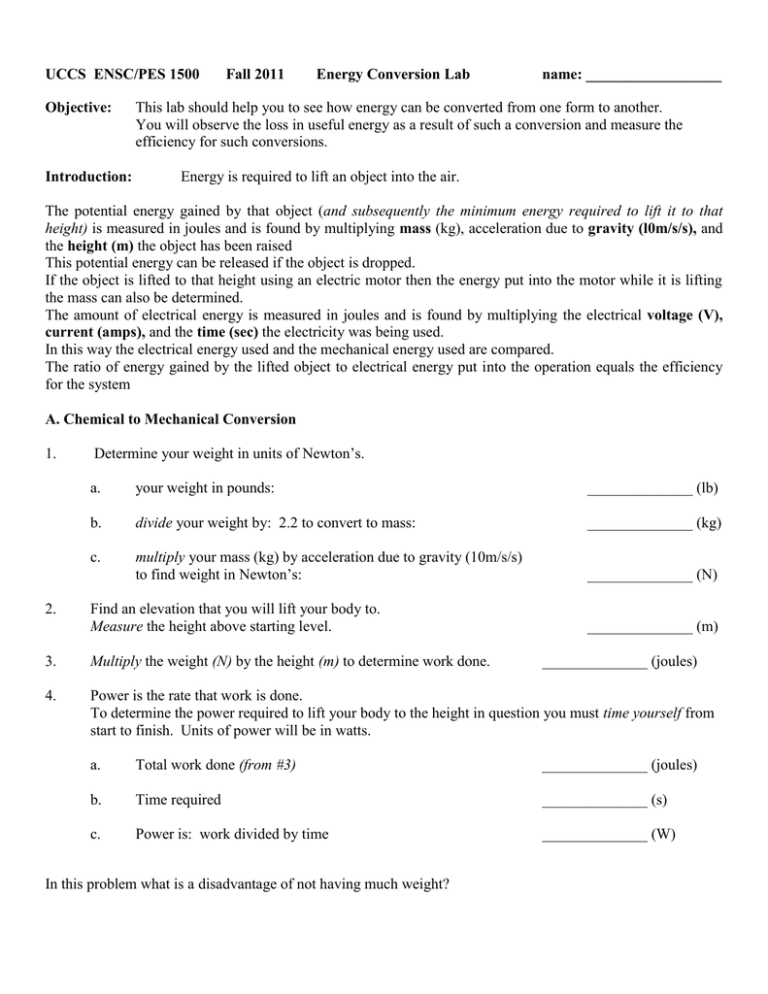
UCCS ENSC/PES 1500 Objective: Introduction: Fall 2011 Energy Conversion Lab name: __________________ This lab should help you to see how energy can be converted from one form to another. You will observe the loss in useful energy as a result of such a conversion and measure the efficiency for such conversions. Energy is required to lift an object into the air. The potential energy gained by that object (and subsequently the minimum energy required to lift it to that height) is measured in joules and is found by multiplying mass (kg), acceleration due to gravity (l0m/s/s), and the height (m) the object has been raised This potential energy can be released if the object is dropped. If the object is lifted to that height using an electric motor then the energy put into the motor while it is lifting the mass can also be determined. The amount of electrical energy is measured in joules and is found by multiplying the electrical voltage (V), current (amps), and the time (sec) the electricity was being used. In this way the electrical energy used and the mechanical energy used are compared. The ratio of energy gained by the lifted object to electrical energy put into the operation equals the efficiency for the system A. Chemical to Mechanical Conversion 1. 2. Determine your weight in units of Newton’s. a. your weight in pounds: ______________ (lb) b. divide your weight by: 2.2 to convert to mass: ______________ (kg) c. multiply your mass (kg) by acceleration due to gravity (10m/s/s) to find weight in Newton’s: ______________ (N) Find an elevation that you will lift your body to. Measure the height above starting level. ______________ (m) 3. Multiply the weight (N) by the height (m) to determine work done. ______________ (joules) 4. Power is the rate that work is done. To determine the power required to lift your body to the height in question you must time yourself from start to finish. Units of power will be in watts. a. Total work done (from #3) ______________ (joules) b. Time required ______________ (s) c. Power is: work divided by time ______________ (W) In this problem what is a disadvantage of not having much weight? Energy: Its Use & the Environment, fourth edition Multiple Choice Questions © 2006 Brooks/Cole, a division of Thomson Learning, Inc. CHAPTER 1: INTRODUCTION 1. Which of the following statements is true (only one): a. The growth rate of energy consumption has kept pace with GNP growth. b. Oil use has expanded more than any other fuel since 1940. c. We reached the point last year where we imported no oil. d. Electricity use has actually fallen since 1975. 2. Which of the following is a non-renewable resource? a. uranium b. water c. wind d. biomass e. radiant solar 3. Today, the U.S. imports about what percentage of the oil it uses? a. 10% b. 25% c. 40% d. 60% e. 80% 4. One of the primary motivating forces behind our per capita reduction in energy use in the 1980’s was _____________. a. a smaller population growth b. higher oil prices c. increased nuclear power costs d. increased domestic oil discoveries 5. The most significant aspect of world consumption of energy over the last 40 years has been the ________. a. growth of nuclear power b. expanding use of oil c. increased use of coal d. emphasis on energy conservation e. increase in our fossil fuel reserves 6. If you started with $100 in the bank and you had $200 after letting it sit there for 5 years, what would be the annual interest rate you received? a. 2% b. 5% c. 10% d. 14% e. 22% 7. Continued use of the fuels most relied upon in developing countries will eventually lead to ________. a. depletion of soil nutrients b. severe thermal pollution of water c. increased oil prices d. depletion of coal reserves in those countries 8. If the growth rate of the number of solar collectors is 7% per year, then 1000 units in use in 2010 will grow to _______ units by the year 2040. a. 1200 b. 2000 c. 4000 d. 8000 e. 20,000 9. The Hubbert curve for an energy resource displays what quantity on the y-axis? a. time b. total production c. yearly production d. amount of fuel left

